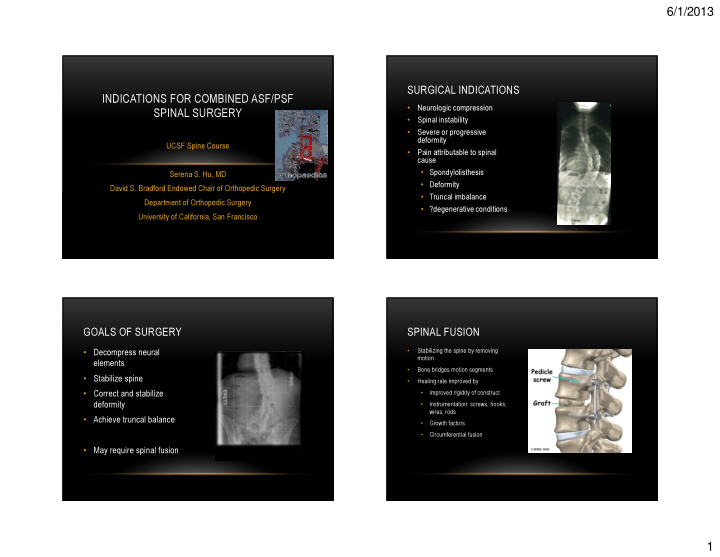



6/1/2013 SURGICAL INDICATIONS INDICATIONS FOR COMBINED ASF/PSF • Neurologic compression SPINAL SURGERY • Spinal instability • Severe or progressive deformity UCSF Spine Course • Pain attributable to spinal cause • Spondylolisthesis Serena S. Hu, MD • Deformity David S. Bradford Endowed Chair of Orthopedic Surgery • Truncal imbalance Department of Orthopedic Surgery • ?degenerative conditions University of California, San Francisco GOALS OF SURGERY SPINAL FUSION • • Decompress neural Stabilizing the spine by removing motion elements • Bone bridges motion segments • Stabilize spine • Healing rate improved by • Correct and stabilize • Improved rigidity of construct • deformity Instrumentation: screws, hooks, wires, rods • Achieve truncal balance • Growth factors • Circumferential fusion • May require spinal fusion 1
6/1/2013 INDICATIONS FOR COMBINED SURGERY INDICATIONS FOR COMBINED SURGERY • High risk of • High risk of pseudoarthrosis pseudoarthrosis • Prior pseudoarthrosis • Prior pseudoarthrosis • Deficient bone stock INDICATIONS FOR COMBINED SURGERY • High risk of pseudoarthrosis • Prior pseudoarthrosis • Deficient bone stock • Long fusion to sacrum 2
6/1/2013 INDICATIONS FOR COMBINED SURGERY INDICATIONS FOR COMBINED SURGERY • High risk of • High risk of pseudoarthrosis pseudoarthrosis • Prior pseudoarthrosis • Prior pseudoarthrosis • Deficient bone stock • Deficient bone stock • Long fusion to sacrum • Long fusion to sacrum • Improve curve correction • Improve curve • Sagittal balance • Coronal balance: correction shoulders, trunk • Sagittal balance INDICATIONS FOR COMBINED SURGERY ACHIEVING CIRCUMFERENTIAL FUSION • High risk of pseudoarthrosis • Prior pseudoarthrosis • Open anterior approach • Deficient bone stock • Lateral approach • Long fusion to sacrum • Posteriorly based approach • Improve curve correction • PLIF • Sagittal balance • TLIF • Coronal balance: shoulders, trunk • Clinical deformity (don’t forget thoracoplasties) 3
6/1/2013 ANTERIOR APPROACH LATERAL APPROACHES • Advantages • Advantages • Most complete removal of disc • Less invasive • Least risk to neural elements • ?less pain • Most correction of sagittal • Technique allows horizontalization deformity of disc space • Disadvantages • Disadvantages • Most invasive • More nerve retraction (esp L4-5) • Abdominal muscle weakness • Cannot access L5-S1 • Risk of DVT • May still have muscle weakness • May need vascular surgeon for • approach More xray exposure WHEN TO STAGE? POSTERIOR BASED APPROACH: TLIF, PLIF • Surgery too long (>12 • Advantages: hours) • Same incision as posterior • Patient unable to tolerate • Can decompress directly • Coagulopathy • Pulmonary • Disadvantages • Cardiac • Nerve retraction • Surgeon unable to tolerate • Least disc resection • ?decreased efficiency • Least lordosis restoration • ?technical fatigue • Less experienced staff 4
6/1/2013 IMPROVE DEFORMITY CORRECTION 60 yo WF, healthy • After first stage ALIF progressive and L4-5 and L5-S1 increasingly painful • XLIF L1-2, L2-3, L3-4 curve Has lived with deformity all of adult life, but now • Traditionally, this might that she has opportunity have included a TL to correct, she wants anterior approach maximal deformity correction RISKS OF STAGED SURGERY • Nutritional depletion • Pulmonary compromise • Development of complications: may delay, preclude 2 nd stage • Longer hospital stay • Increased costs 5
6/1/2013 NUTRITIONAL DEPLETION PULMONARY COMPLICATIONS • Nutritional • Preexisting disease supplementation: staged • spinal surgery Thoracotomy • High EBL • TPN • Fluid shifts • Decreased nutritional • Transfusion-related ARDS depletion (prealbumin) • Higher rate of pneumonias, infectious complications in malnourished patients DECISION MAKING ALTERNATIVES • Potential role for widely • Risk-benefit ratio staged surgery? • Lumbar fusion • Delayed thoracic fusion • Posterior first: repair pseudo or Thomasen • Delayed ASF • ?older patients 6
6/1/2013 THANK YOU SUMMARY • Indications for combined surgery • Increase fusion rate • Improve deformity correction and balance • Options for circumferential fusion • ASF • Lateral fusion • Posterior interbody • Selection based on indications for surgery and risk benefit ratio FOR MORE INFORMATION WWW.ISSLS.ORG 7
Recommend
More recommend